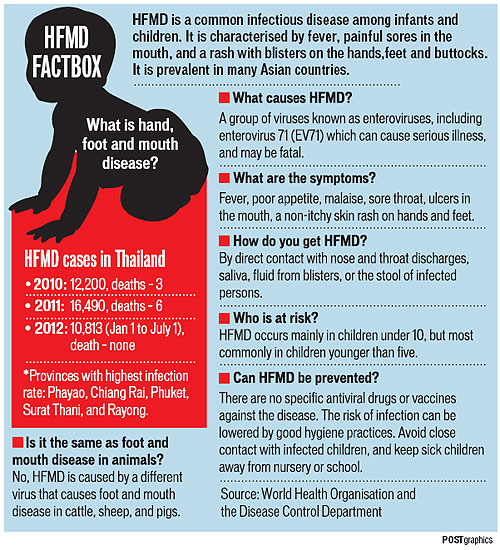
Extraordinary surveillance measures were being implemented to keep Enterovirus Type 71 (EV-71), a strain of HFMD that has claimed the lives of more than 60 children in Cambodia, from spreading to Thailand, Dr Surawit said.
Parents are being advised to encourage their children to wash their hands often and avoid taking them to crowded places, Dr Surawit said.
If parents suspect an infection they should immediately take their children to a doctor to reduce the risk of complications of the disease which can affect victims' brains, lungs, and hearts, he said.
Authorities have sent a communicable disease control unit to the Chong Jom-Osamach border crossing in tambon Dan of Kap Choeng district of Surin to screen Cambodian parents and their children for HFMD virus strains.
Any Cambodian travellers suspected of carrying the virus would be quarantined, the Surin provincial health office said.
Meanwhile, parents of 16 Cambodian children attending a pre-school child centre in Ban Dan in the same border district of Surin were asked to take their children back to Osamach in Cambodia.
Sirichai Tantiratananon, president of tambon Ban Dan administration organisation, said it was a temporary measure to prevent the children infecting their Thai peers.
Satawas Sinprasitkul, director of Kap Choeng district hospital, said no Cambodian patients with EV-71 has been admitted to his hospital since the virus was found across the border three months ago.
Dr Apichart Rodsom, chief of the provincial health office in Kanchanaburi, said four new HFMD cases in children aged three to five which were reported this week were not the EV-71 strain.
EV-71 is one of two pathogens commonly found in infected Thai patients, but it was a virulent form of the virus that was detected in recent Thai cases, the permanent secretary for public health, Dr Paijit Warachit, said. The other type of HFMD virus commonly found in Thailand is Coxsackie A 16, he said.
http://www.bangkokpost.com/news/loca...eputy-minister







 According to Ben Tre Veterinary Department, the three southern provinces as Binh Duong, Dong Nai and Bac Lieu has announced blue ear pig. This disease tends to spread and the annual peak in July, 8 calendar.
According to Ben Tre Veterinary Department, the three southern provinces as Binh Duong, Dong Nai and Bac Lieu has announced blue ear pig. This disease tends to spread and the annual peak in July, 8 calendar.
